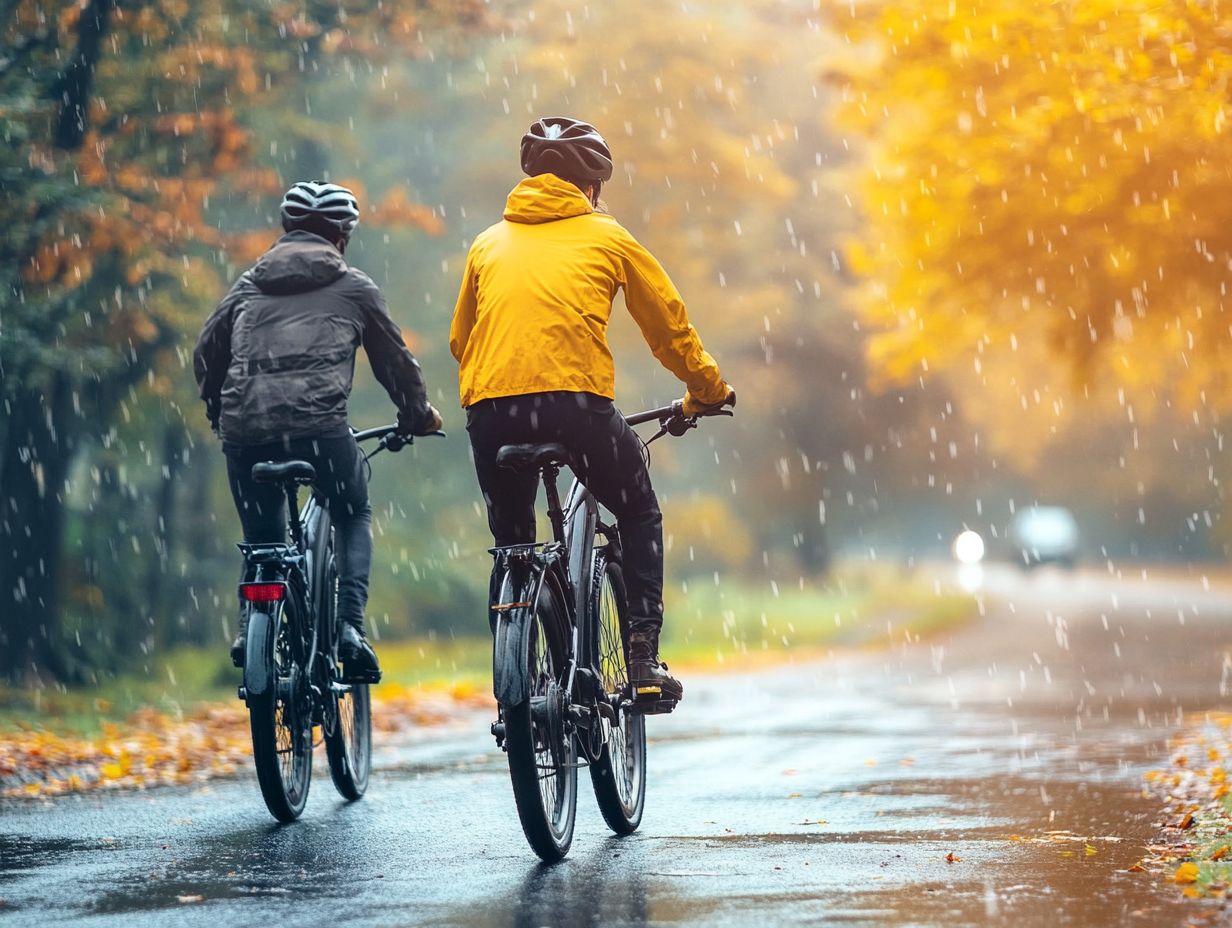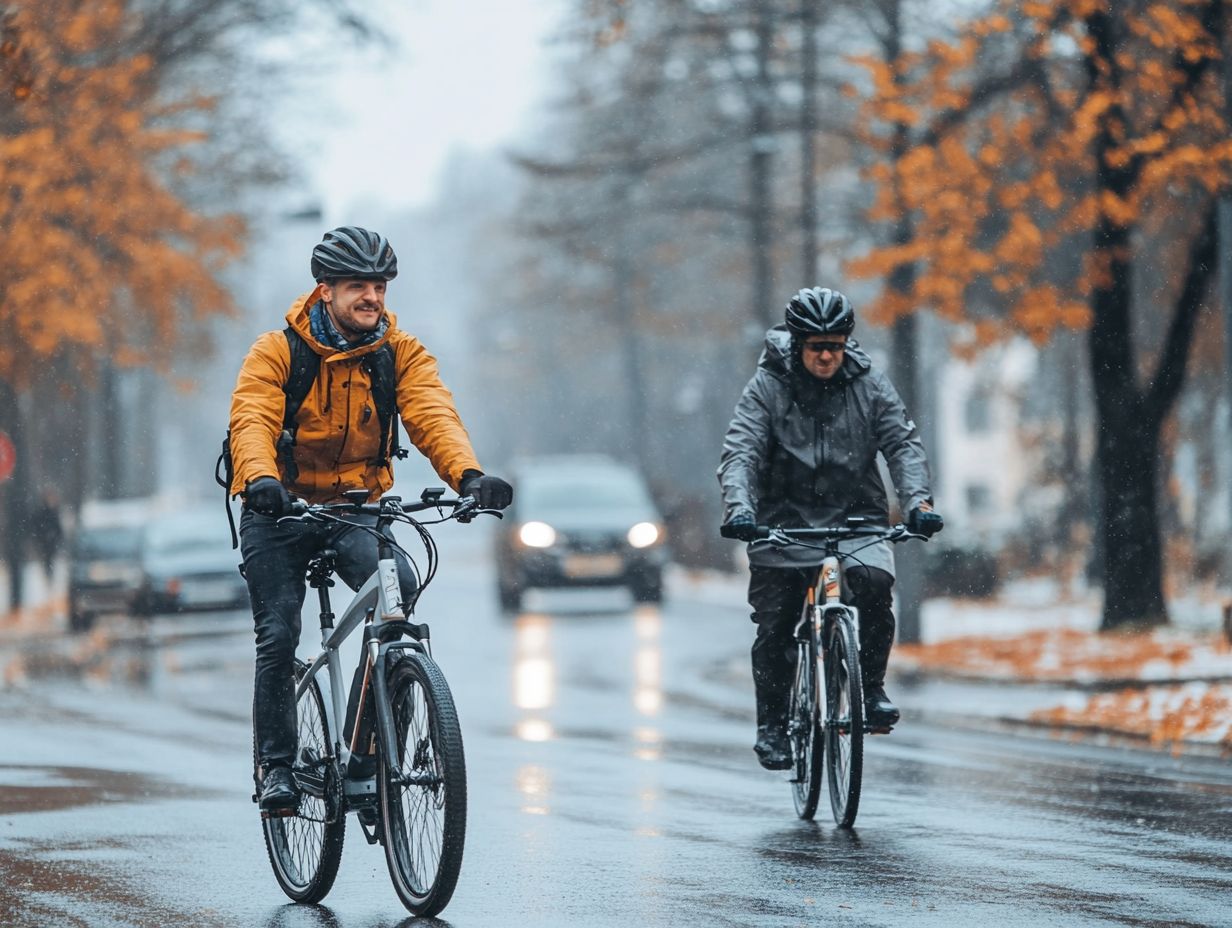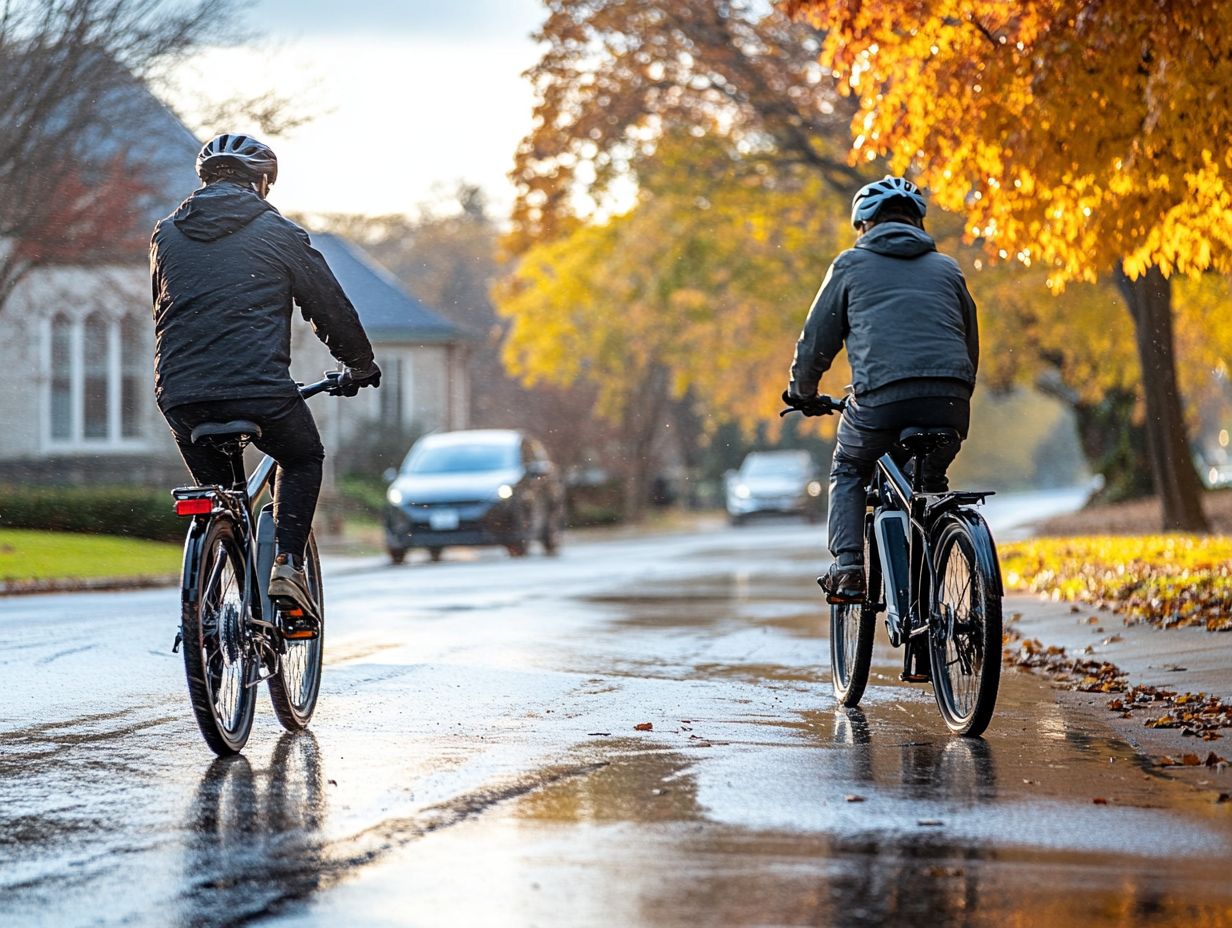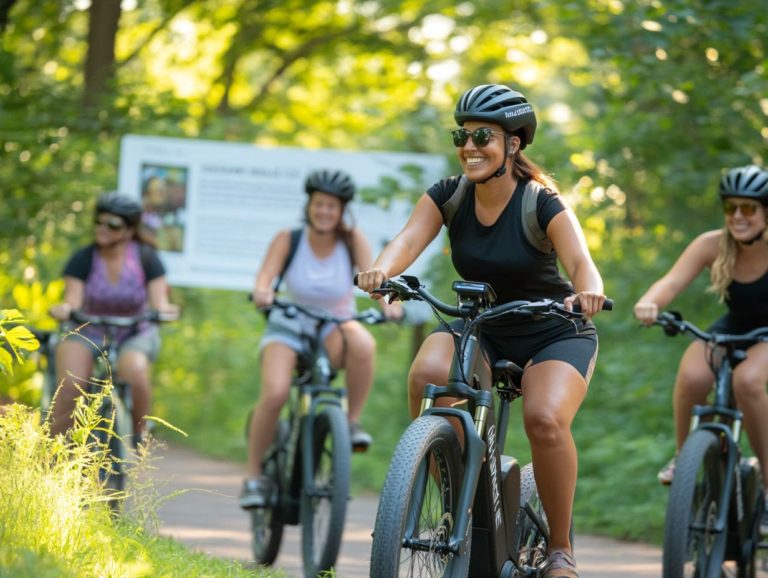What is the Impact of Weather on E-Biking?
E-biking presents an exhilarating opportunity to immerse yourself in the great outdoors! Yet, it’s essential to recognize how weather conditions can shape your experience.
Whether you’re navigating rain-soaked streets or basking under a scorching sun, understanding the impact of various elements on your ride is paramount. This guide delves into the essence of e-biking and explains how different weather patterns influence both your safety and enjoyment.
You will find valuable tips for overcoming various weather challenges, ensuring you remain comfortable and confident, regardless of what the forecast holds. Learn how to adjust your itinerary accordingly.
Contents
- Key Takeaways:
- Understanding E-Biking
- The Role of Weather in E-Biking
- Benefits of E-Biking in Different Weather Conditions
- Preparing for Different Weather Conditions
- Frequently Asked Questions
- What is the Impact of Weather on E-Biking?
- How does rain affect e-biking?
- Does wind affect e-biking?
- Is it safe to e-bike in extreme weather conditions?
- How does temperature affect e-bike battery life?
- What precautions should I take when e-biking in hot weather?
- How can I prepare for e-biking in different weather conditions?
Key Takeaways:

- Weather plays a crucial role in e-biking, affecting both the rider and the bike’s performance.
- E-biking in different weather conditions has its benefits, such as increased resistance training in hot weather and reduced impact on joints in cold weather.
- Proper preparation is essential for e-biking in various weather conditions, including wearing suitable gear and adjusting riding techniques.
Understanding E-Biking
Understanding e-biking means diving into the world of electric bicycles, or e-bikes. These vehicles provide a sustainable option for riding around the city and offer a refreshing alternative to traditional transport methods.
E-bikes combine convenience, efficiency, and eco-friendliness, enabling you to navigate city streets while reducing your environmental footprint. Take the Macfox e-bike and Cruiser Bike as examples; they showcase the versatility and allure of e-bikes, catering to everyone from casual riders to dedicated cyclists.
Whether you’re riding for leisure or running errands, grasping the nuances of e-biking is key to unlocking its full potential.
What is E-Biking?
E-biking is about embracing the electric bicycle, which is designed with an electric motor to give you a boost while pedaling. This makes riding around the city not just easier but downright enjoyable!
These remarkable machines come equipped with various components, including a rechargeable battery, a motor, and a controller. These work together to provide you with a seamless riding experience. As you navigate city streets, you can choose different levels of assistance, allowing you to customize your journey to match your fitness level and the terrain ahead, which may include blustery conditions or temperature extremes.
The benefits are plentiful e-bikes simplify travel by reducing the effort required for long distances or tackling steep hills. Plus, they play a pivotal role in sustainable urban transportation solutions. By opting for cycling over driving, you contribute to less traffic congestion and lower carbon emissions, while promoting a healthier environment and lifestyle for yourself and the community.
The Role of Weather in E-Biking
The role of weather in e-biking is crucial, as various conditions can significantly influence your e-bike’s performance, your safety, and your overall experience.
Elements such as temperature, moisture, wind resistance, and thermal conditions, along with moisture-induced challenges, directly affect battery efficiency and riding comfort. Whether you’re navigating through frosty streets or battling sweltering heat, understanding how weather impacts your e-bike journey is vital for optimizing performance and ensuring an enjoyable ride.
By considering these weather-related factors, e-biking can remain a reliable commuting option across all seasons.
Get ready for your next adventure in e-biking!
How Weather Affects E-Biking
Weather conditions can profoundly affect your e-bike performance, influencing key factors such as traction, battery efficiency, and your overall comfort while commuting.
For example, when heavy rainfall hits, those slick surfaces become a serious concern. It s crucial for you to exercise caution, as wet roads and moisture tend to reduce grip and lengthen stopping distances. Similarly, snow introduces its own set of challenges. Accumulation can significantly compromise traction, causing your e-bike to struggle with stability.
When icy conditions emerge, staying vigilant is non-negotiable. The lack of friction can lead to perilous slips or falls. Moisture from rain or snow can affect your battery s performance too. Colder temperatures might also demand more energy to maintain optimal efficiency, ultimately compromising your safety and comfort during rides.
Benefits of E-Biking in Different Weather Conditions

E-biking offers amazing benefits that keep you active and eco-friendly, no matter the temperature or precipitation. By giving you the power to stay engaged, e-biking transcends various weather conditions.
When you utilize electric bicycles or e-bikes in different scenarios, you elevate your commuting experience. Embrace unique advantages tailored to each circumstance, whether in frosty conditions, on rainy streets, battling sweltering heat, or navigating icy paths. E-bikes remain versatile and appealing, solidifying their status as an ideal choice for urban commuting.
By understanding these benefits, you can fully enjoy e-biking year-round while simultaneously reducing your carbon footprint.
Advantages of E-Biking in Rainy Weather
E-biking in rainy weather comes with its perks, such as improved traction and the chance for a more controlled riding posture. This makes it an exciting option for commuters, even when the skies are gray.
When equipped with the right winter tires, slick surfaces can actually become a playground for your e-bike. Enjoy better grip and stability during tricky turns, allowing you to navigate wet puddles and slippery roads without sacrificing speed or safety.
If you’re brave enough to venture out in the rain, it s wise to take some precautions. Wear visibility-enhancing gear and adjust your riding speed to reduce assistance settings on the e-bike. Simple strategies like keeping a safe distance from other vehicles and being mindful when braking can significantly boost your safety.
With these tips in mind, you ll find that rainy rides can be not just manageable, but genuinely enjoyable.
Benefits of E-Biking in Hot Weather
E-biking in hot weather brings a host of unique benefits, like enhanced battery efficiency and a riding posture that lets you enjoy longer journeys while remaining comfortably cool, especially in sweltering climes.
You can make the most of these favorable conditions by selecting optimal routes that offer plenty of shade, such as tree-lined paths or trails meandering near water bodies. Staying hydrated is essential, so carrying a water bottle is a must; sip water regularly instead of waiting until thirst kicks in.
Tweaking your bike s settings can elevate your experience even further. Opt for eco-mode, which helps conserve battery life while still providing assistance. This allows you to cover greater distances without the anxiety of running out of power. By being mindful of these elements, you can truly savor your rides while skillfully navigating the heat.
Why E-Biking is Great for Cold Weather
E-biking presents a remarkable solution for cold weather. It provides enhanced traction through winter tires and helps you navigate moisture-laden commutes in frosty conditions.
To truly relish the advantages of this eco-friendly transport during winter months, it s vital to consider the right equipment. Investing in high-quality winter tires designed for colder temperatures can greatly enhance your grip on icy surfaces. Regular maintenance checks, such as battery care and brake assessments, are essential to avoid unwelcome surprises on the road.
You may need to adjust your speed and braking techniques. Take it slow to navigate tricky spots, especially in blustery conditions. With these precautions in place, embracing the chill on two wheels can be both a delightful and safe experience.
Preparing for Different Weather Conditions
Preparing for various weather conditions is crucial for your e-biking experience. By taking specific precautions, you can significantly enhance both safety and performance while navigating extreme weather.
Understanding the challenges posed by rain, temperature extremes, and moisture empowers you to adjust your itinerary and riding techniques effectively. Implementing strategies for bad weather ensures a more enjoyable ride and helps prolong the life of your electric bicycle.
Equip yourself with the knowledge necessary to prepare for your e-biking journeys, no matter what the weather throws your way.
Tips for E-Biking in Rainy Weather

To ensure a safe e-biking experience in rainy weather, embrace specific strategies that enhance traction and maintain optimal riding posture.
For instance, slow down, as wet pavement can significantly diminish grip, especially during extreme weather. Invest in high-quality waterproof gear to stay dry and comfortable. This allows you to focus better and truly enjoy your ride, enhancing your overall e-biking experience.
Stay mindful of your surroundings. Avoid sudden movements or sharp turns, as these can lead to slips. Opt for wider tires to bolster your stability on slick surfaces.
By taking these precautionary measures, you enhance your safety and overall enjoyment, making for a more pleasant commute in challenging weather conditions.
How to Handle E-Biking in Hot Weather
Handling e-biking in hot weather requires savvy strategies to maximize your battery efficiency while ensuring a comfortable ride. It s not just about keeping your bike in top shape; timing plays a crucial role in your experience.
Plan your rides to steer clear of the hottest hours for a more comfortable experience! Don’t underestimate the power of staying well-hydrated. It keeps your focus sharp on those sunny trails.
Regular maintenance checks on your e-bike are essential, particularly for tire pressure and brake performance, to ensure everything operates optimally. Keep an eye on your battery life to manage it effectively. On sweltering rides, avoid relying too heavily on pedal assistance and opt for eco-mode whenever possible. Glide through the heat with ease and efficiency!
Staying Safe while E-Biking in Cold Weather
Staying safe while e-biking in cold weather requires you to take key precautions, such as using winter tires and dressing appropriately for the elements.
Selecting tires designed for traction on icy surfaces is vital. Layer your clothing to maintain body heat without risking overheating during exertion. Insulating base layers, windproof jackets, and thermal gloves can make a frigid ride much more manageable.
Regularly check your bike s components, especially those affected by moisture, like brakes and gears, since ice and grit can significantly impact performance.
Set aside time for routine maintenance, like applying oil to the bike chain and checking tire pressure. This will enhance your bike s reliability and minimize the chances of accidents or mechanical failures in harsh conditions.
Frequently Asked Questions
What is the Impact of Weather on E-Biking?
Weather can significantly impact e-biking, affecting everything from rider safety to bike performance. Here are some FAQs to help you understand the effects of weather on e-biking.
How does rain affect e-biking?

Rain can make e-biking more challenging by reducing visibility, creating slippery road conditions, and increasing accident risks. Take extra precautions and wear appropriate rain gear when e-biking in the rain.
Does wind affect e-biking?
Yes, strong winds can significantly impact e-biking, especially on open roads. Wind resistance can make pedaling more difficult and decrease battery life on electric bikes. Adjust your riding style and use lower power settings when e-biking in windy conditions.
Is it safe to e-bike in extreme weather conditions?
It is not recommended to e-bike in extreme weather conditions such as thunderstorms, snowstorms, or extreme heat. These conditions can be dangerous for riders and may damage e-bike components. Wait for better weather before hitting the road your safety comes first!
How does temperature affect e-bike battery life?
Cold temperatures can decrease e-bike battery life, while hot temperatures can increase it. Store e-bikes in a temperature-controlled environment and keep the battery charged to ensure optimal performance.
What precautions should I take when e-biking in hot weather?
In hot weather, stay hydrated, wear sunscreen, and take breaks to avoid heat exhaustion. Monitor the e-bike’s battery and motor temperature, as extreme heat can cause damage to these components.
How can I prepare for e-biking in different weather conditions?
The best way to prepare is to check the forecast before heading out and dress appropriately. Ensure you have a fully charged battery, proper safety gear, and adjust your riding style and speed according to the weather conditions.
Have your own tips? Share your experiences or sign up for more tips on staying safe while e-biking!






